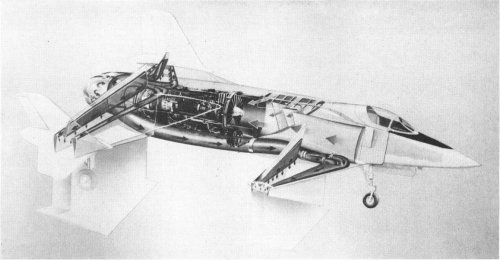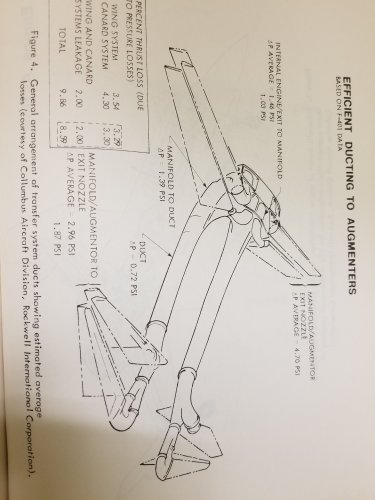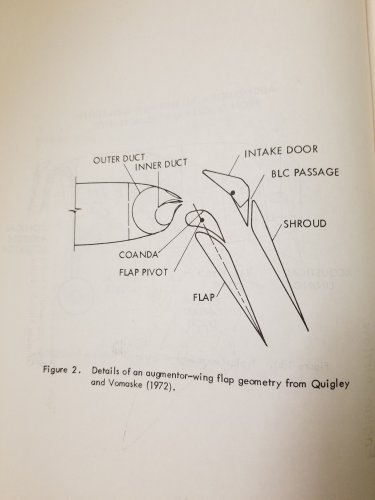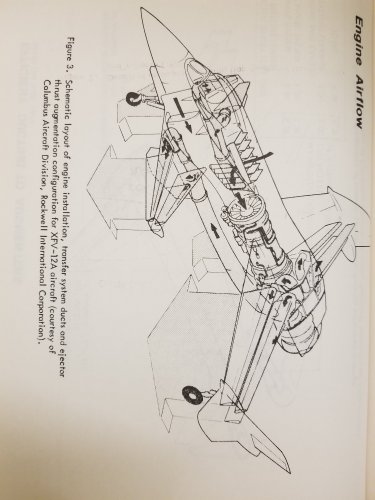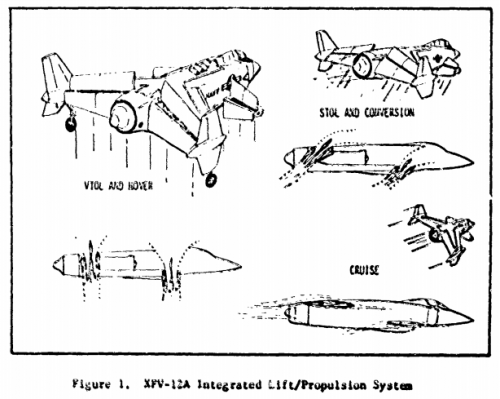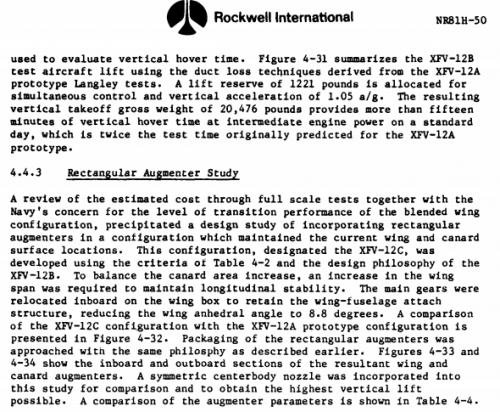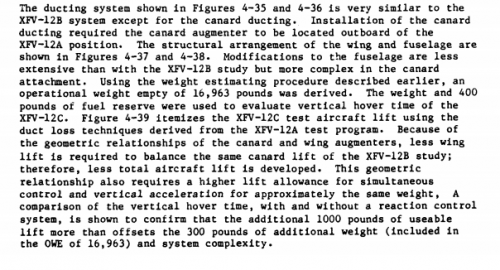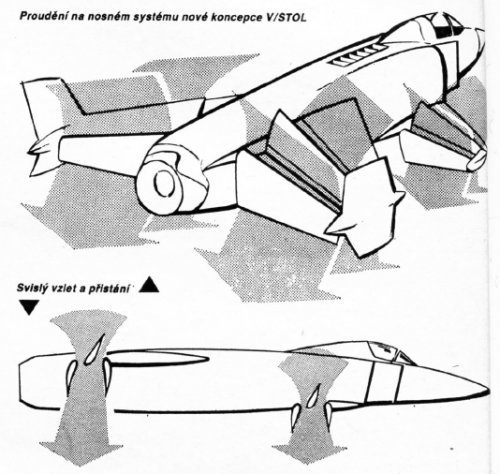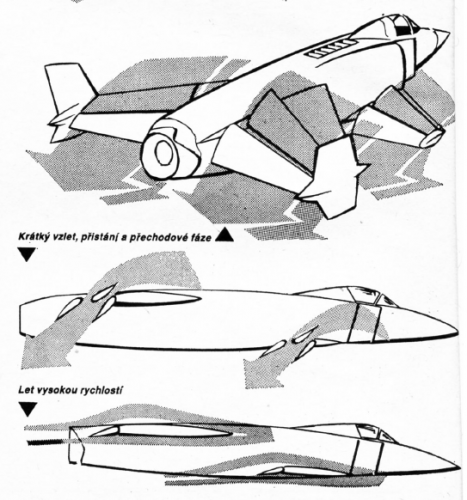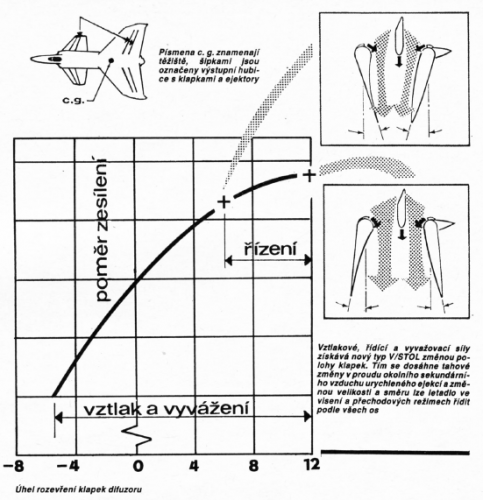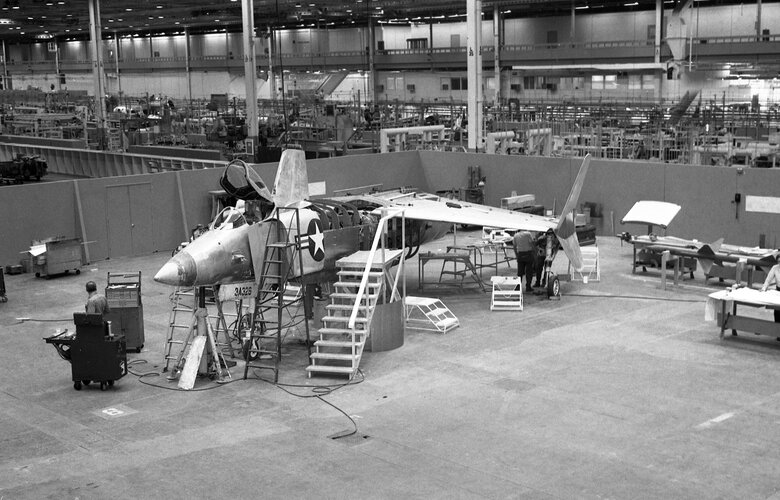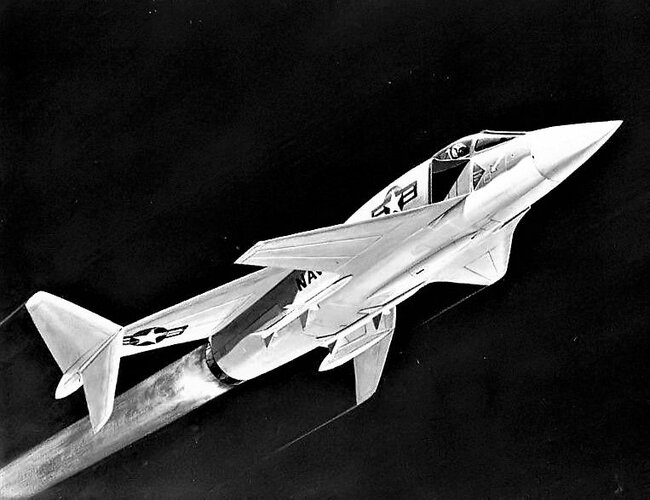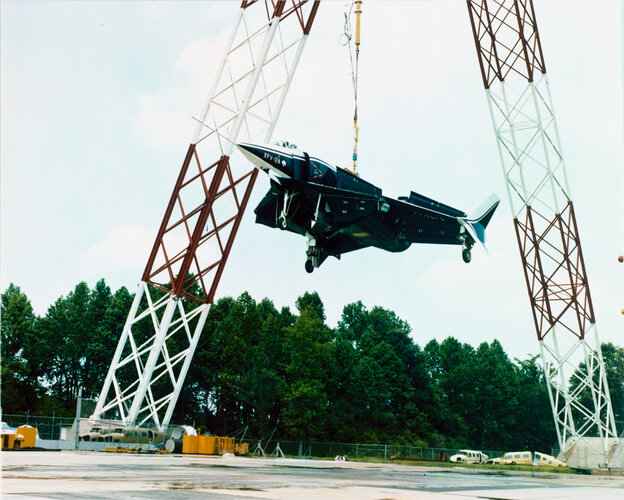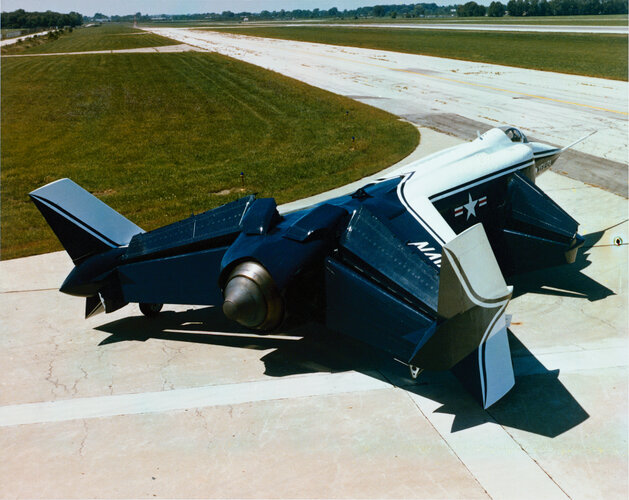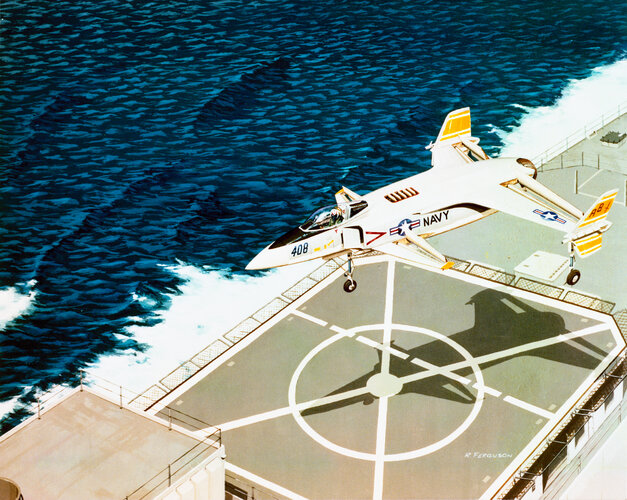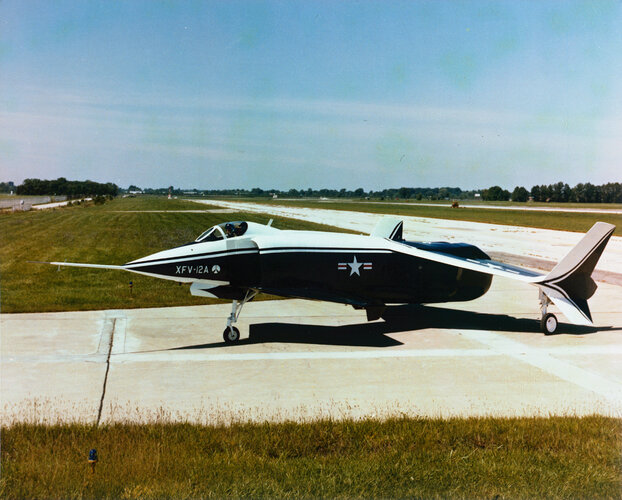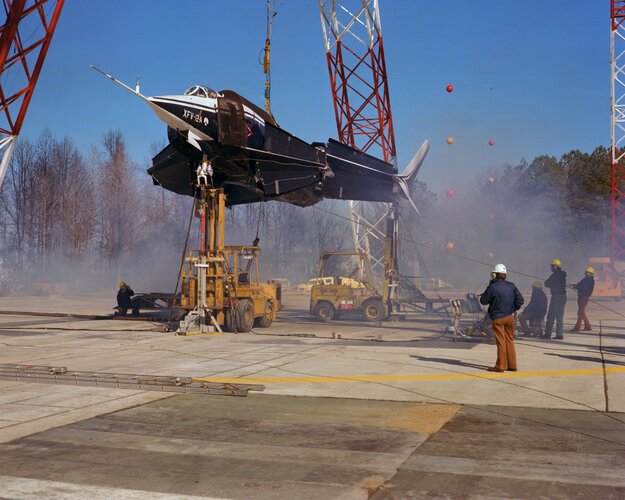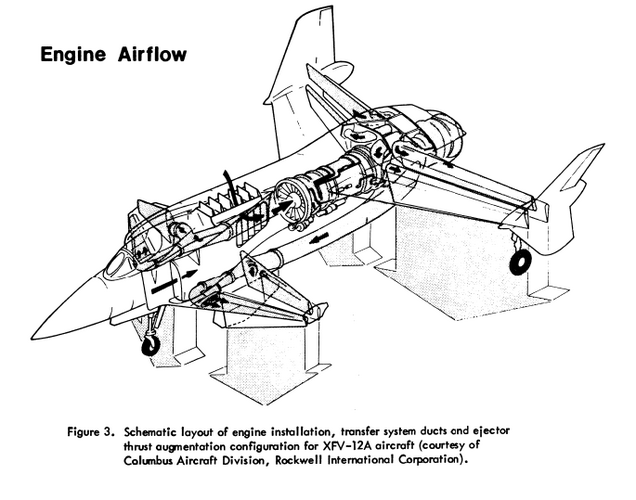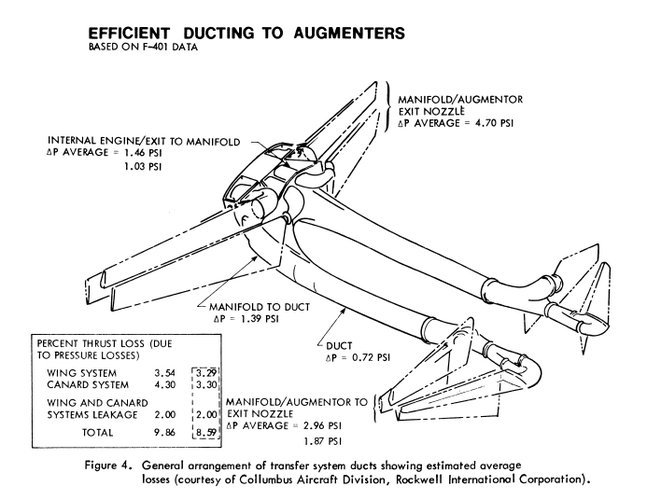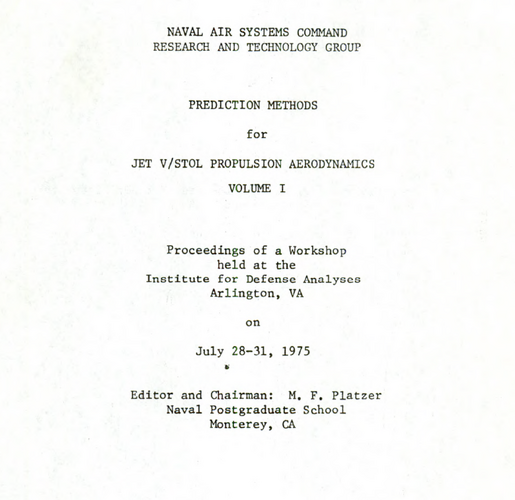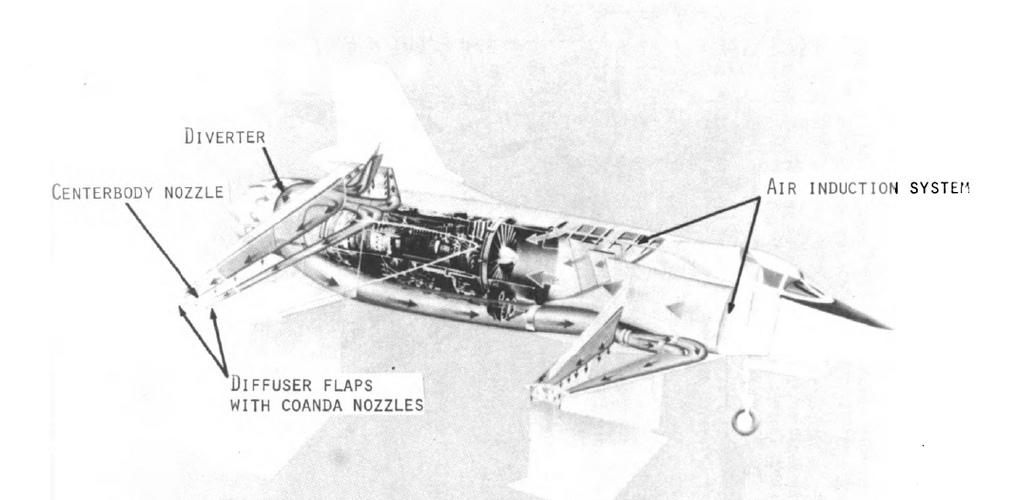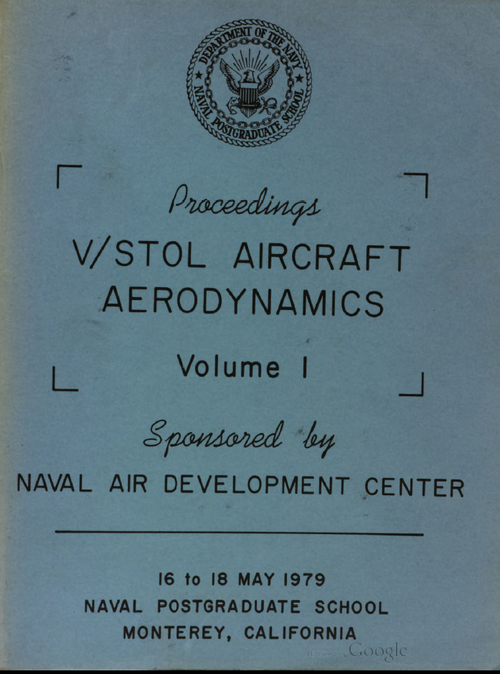You are using an out of date browser. It may not display this or other websites correctly.
You should upgrade or use an alternative browser.
You should upgrade or use an alternative browser.
Rockwell NR-356 Sea Control Ship (SCS) V/STOL fighter (XFV-12A)
- Thread starter KnightTemplar
- Start date
ScrutorAudax
ACCESS: Confidential
- Joined
- 4 June 2015
- Messages
- 66
- Reaction score
- 99
I found this at my library. If anyone wants more information or a better scan, I can do that. There was also quite a bit on lift augmentation in general and as it pertains to this aircraft.
Attachments
- Joined
- 26 May 2006
- Messages
- 34,922
- Reaction score
- 15,794
hesham said:here is a report about Rockwell XFV-12.
http://www.dtic.mil/dtic/tr/fulltext/u2/a108354.pdf
From the same report,
a small Info about XFV-12B & XFV-12C.
Attachments
- Joined
- 13 June 2007
- Messages
- 2,173
- Reaction score
- 3,096
kaiserd
I really should change my personal text
- Joined
- 25 October 2013
- Messages
- 1,657
- Reaction score
- 1,726
It’s certainly one of the last major prototype “well that didn’t work at all“ case studies, which have largely been eliminated via advanced in computer modelling etc.
Given the concept has never really been revisited (but that there was plenty of subsequent US and UK V/STOVL research etc. eventually leading to the F-35B) I think we can safely understand that no one thought they could readily “fix” this failed concept.
Given the concept has never really been revisited (but that there was plenty of subsequent US and UK V/STOVL research etc. eventually leading to the F-35B) I think we can safely understand that no one thought they could readily “fix” this failed concept.
- Joined
- 21 May 2006
- Messages
- 3,003
- Reaction score
- 2,284
Did you ever build that model Archibald?Yeah, better option would have been its competitor, the General Dynamics 200. This one was really similar to the soviets Yak 36 /38 /41 in the sense that it had a tilting rear exhaust plus two lift jets behind its cockpit.
Despite its defaults (hot gases reingestion) this layout WORKS rather well.
I'm planing a model of the General Dynamics design using a Gripen as basis...
For more info on the GD 200A, browse the "US V/STOL projects" thread. 9 pages of oddball designs (I'm fond of the well-named NUTcrakers designs ;D)
Regards
Pioneer
- Joined
- 21 May 2006
- Messages
- 3,003
- Reaction score
- 2,284
Sneak peek, sneak peek!!!!Yeeees. One of my best built. I had some pictures on Photobucket but... oh well forget it.
Regards
Pioneer
Last edited:
- Joined
- 3 September 2006
- Messages
- 1,476
- Reaction score
- 1,473
Some things that work on a small model do scale up, others don't.I remember the excitement surrounding the bizarre looking XFV12.
Was there any way of getting it to work? Or should the engineers have realised there would not be enough lift generated?
The lift augmentation concept of the XFV-12 is one of those that don't.
As wiki says in https://en.wikipedia.org/wiki/Rockwell_XFV-12 : "Lab tests showed 55% thrust augmentation should be expected; however, differences in the scaled-up system dropped augmentation levels to 19% for the wing and a mere 6% in the canard."
So indeed, there would not be enough lift generated.
Some things that work on a small model do scale up, others don't.
In aerospace, a *lot* of things work better the bigger you get (see: Project Orion, rocket engines, SSTO). But augmentor lift turned out to be the opposite. Didn't just kill the XFV-12, it made the idea of a VTOL C-130 with augmentor lift wings *laughable.*
taildragger
You can count on me - I won a contest
- Joined
- 2 November 2008
- Messages
- 404
- Reaction score
- 502
I don't think computer modeling would have prevented the XV-12A failure. Modeling or CFD (Computational Fluid Dynamics) is based on real world observations and if nobody had ever built an augmentor lift system (or similar hardware) on the scale of the XV-12A, the software would have no basis for predicting that it wouldn't work.It’s certainly one of the last major prototype “well that didn’t work at all“ case studies, which have largely been eliminated via advanced in computer modelling etc.
- Joined
- 3 September 2006
- Messages
- 1,476
- Reaction score
- 1,473
Sure. It is just surprising to me that they wouldn't build just one wing and blow a jet though it,
--BEFORE building the whole freaking airplane at max cost.
Risk reduction in project management, all the things we learn in school...
--BEFORE building the whole freaking airplane at max cost.
Risk reduction in project management, all the things we learn in school...
- Joined
- 9 October 2009
- Messages
- 21,979
- Reaction score
- 13,647
Regarding the 'VTOL long range sensor aircraft', aka the Bell Seakat, that was supposed to operate alongside the FV-12A:
- Joined
- 16 December 2010
- Messages
- 3,825
- Reaction score
- 4,239
- Joined
- 3 June 2011
- Messages
- 18,348
- Reaction score
- 12,265
- Joined
- 2 May 2007
- Messages
- 497
- Reaction score
- 1,963
Reasonable reproduction of A Unique Facility for V/STOL Aircraft Hover Testing here
An illustrated article on the NR-356 is available in the recently released "US VTOL Projects #3:"
https://www.aerospaceprojectsreview.com/blog/?p=5226


https://www.aerospaceprojectsreview.com/blog/?p=5226
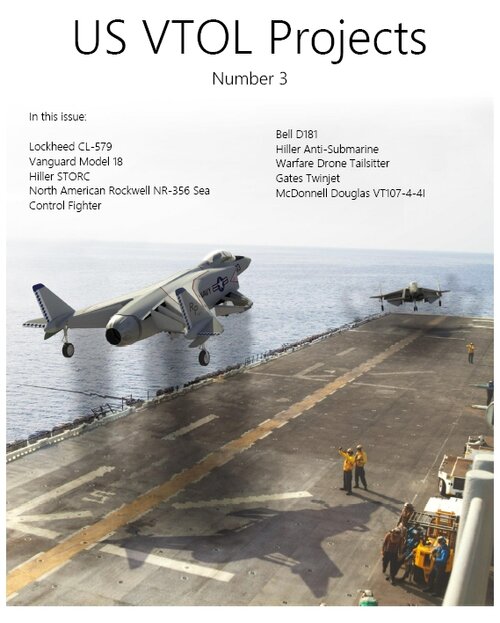
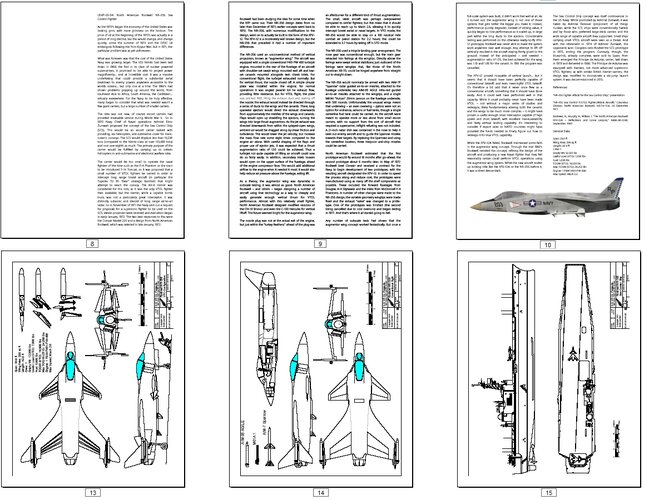
Firefinder
ACCESS: Top Secret
- Joined
- 5 October 2019
- Messages
- 1,050
- Reaction score
- 1,906
Was more talking bout how that was choosen despite several better designs be available.The ducting for the VTOL sucked up so much of the thrust that the XFV-12 was never capable of a vertical takeoff, and the thrust augmentation effects didn't scale up like they thought. Only got 19% augmentation instead of the expected 55%.Depending on when the thing was considered, it was likely that hte Harrier was already IN USN/MC SERCIVE and likely have proven itself in the Falklands. So it could be why re-invent the wheel when we already have something that does the job just as well for now deal.Hybrid warships mentions that Reuven Leopold had some more CSGN Mk 2- like concepts even after CSGN was cancelled so that might refer to those. Hell, on 18000 tons I would even expect it to have conventional propulsion if 18 aircraft had to be shipped, as that was about the displacement of the regular CSGN design. Curious too that it speaks about harriers, although that might of course be the only VSTOL aircraft that actually reached service back then so "VTOL" translated to "harrier" at that point.
That and/or all use attempts failed or got...
What ever happened to the Rockwell deal.
Despite having a 30,000lb thrust engine in a 20,000lb airframe. Flew like a scalded rat in CTOL due to all the power, but couldn't do the VTOL part at all.
Also as far as I know the XFV11 never actually flew... At all.
Like I have never seen mention of the thing flying.
- Joined
- 3 June 2011
- Messages
- 18,348
- Reaction score
- 12,265
Never flew. Sorry. Only time it ever got airborne was hanging from a crane. Now what it MIGHT have been. . .Got pictures of it on the ramp at NAA Columbus, getting ready to get on the runway.It never flew. Please keep the nonsense to a minimum.The ducting for the VTOL sucked up so much of the thrust that the XFV-12 was never capable of a vertical takeoff, and the thrust augmentation effects didn't scale up like they thought. Only got 19% augmentation instead of the expected 55%.Depending on when the thing was considered, it was likely that hte Harrier was already IN USN/MC SERCIVE and likely have proven itself in the Falklands. So it could be why re-invent the wheel when we already have something that does the job just as well for now deal.Hybrid warships mentions that Reuven Leopold had some more CSGN Mk 2- like concepts even after CSGN was cancelled so that might refer to those. Hell, on 18000 tons I would even expect it to have conventional propulsion if 18 aircraft had to be shipped, as that was about the displacement of the regular CSGN design. Curious too that it speaks about harriers, although that might of course be the only VSTOL aircraft that actually reached service back then so "VTOL" translated to "harrier" at that point.
That and/or all use attempts failed or got...
What ever happened to the Rockwell deal.
Despite having a 30,000lb thrust engine in a 20,000lb airframe. Flew like a scalded rat in CTOL due to all the power, but couldn't do the VTOL part at all.
(Though finding out the Frankensteinian combination of parts was also intended to be the production configuration was disappointing. The original design looked pretty sweet.)
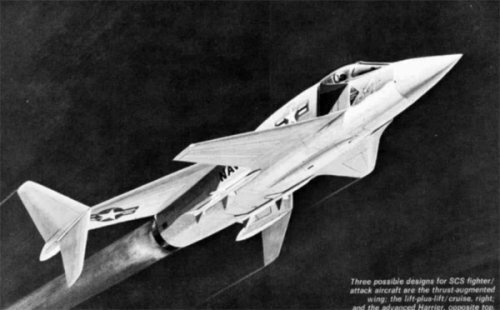
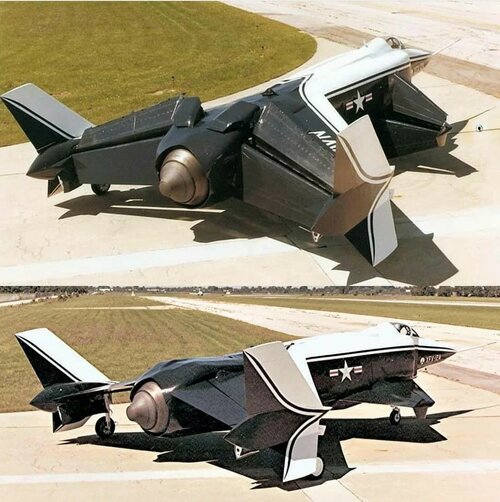
Scott Kenny
ACCESS: USAP
- Joined
- 15 May 2023
- Messages
- 11,676
- Reaction score
- 14,395
Every indication I had seen was that the XFV12 had flown CTOL.But why type this when you clearly had NO supporting evidence, "Flew like a scalded rat in CTOL due to all the power"? That's just making stuff up. I get being wrong but that's fabricated.
And it should have flown like a bat out of hell, what with a power to weight ratio of 1.5:1 at takeoff.
- Joined
- 16 April 2008
- Messages
- 9,616
- Reaction score
- 14,525
There's nothing on Wiki about a fighter with a V-series number but the XFV-12, specifically that the V-11 was unassigned.
Who made the XFV-11?
The XV-11 was actually an experimental aircraft with the first all-composite structure and extensive boundary layer control for STOL. Distinctly not a fighter though.
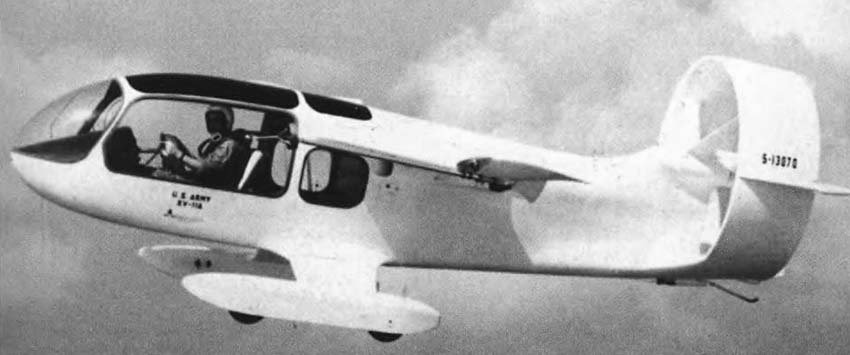
Mississippi State University XV-11 Marvel - Wikipedia
- Joined
- 3 June 2006
- Messages
- 3,094
- Reaction score
- 3,966
Not the same picture, just a different configuration, when you compare the inlets.I thought his point about a STOVL profile was interesting. Didn't know the Frankensteinian prototype was also it's planned production configuration. The original planned configuration is one of my favorites:
View attachment 695954
View: https://flic.kr/p/ecJye6G. Verver said:Rockwell International XFV-12A supersonic fighter/attack "Thrust Augmenter Wing" concept artwork as U.S. Navy BuNo 161080, NK-601, 1974. Illustrator unknown.
- Joined
- 3 June 2011
- Messages
- 18,348
- Reaction score
- 12,265
Yeah, I like this one. Lot more differences than just the intake.Not the same picture, just a different configuration, when you compare the inlets.
View: https://flic.kr/p/ecJye6
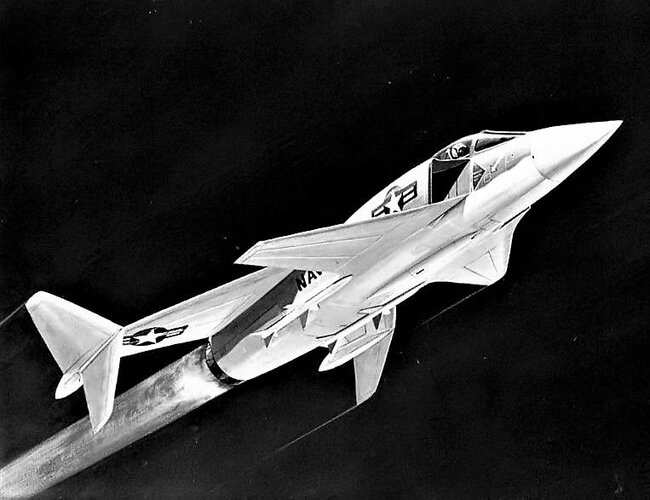
Scott Kenny
ACCESS: USAP
- Joined
- 15 May 2023
- Messages
- 11,676
- Reaction score
- 14,395
I mean, if it can land vertically on an SCS, it can land vertically on a carrier just like the helicopters do...The most heavily armed FV-12 variant I've seen, was the (twin engined) one shown
by circle 5 (#59, 60). This one here looks more or less unarmed, but of course, maybe
it's landing with full tanks.Don't think, that this picture should be taken that seriously,
apart from the fact, that the FV-12A was intended to be CTOL capable. And exactly that's
something, I still don't understand. Cross deck operations between conventional and VSTOL-
carriers ?
Who the heck came up with that deck layout for the carrier? Elevator on the centerline at the rear ramp, and then inside the flight deck forward of the island? *rolls up newspaper* Bad engineer! Elevators go on the edges of the flight deck!!!An illustrated article on the NR-356 is available in the recently released "US VTOL Projects #3:"
https://www.aerospaceprojectsreview.com/blog/?p=5226
- Joined
- 16 April 2008
- Messages
- 9,616
- Reaction score
- 14,525
Who the heck came up with that deck layout for the carrier? Elevator on the centerline at the rear ramp, and then inside the flight deck forward of the island? *rolls up newspaper* Bad engineer! Elevators go on the edges of the flight deck!!!
Not when it's a 14000-ton light carrier with limited freeboard expecting to spend a lot of time in the northern Atlantic. That elevator layout was chosen (apparently) for two criteria. One was to maximize availability in poor weather (hence the internal lift midships) and the other was to somewhat reduce enclosed volume as a cost measure (hence the notched elevator aft). That aft elevator is also well sheltered but allows transom access for an engine test stand, I believe.
It seems to have worked acceptably for the Spanish, who built one as Principe de Asturias.
Note that the original SCS layout did not have a ramp, as that idea hadn't even been tested in 1973-4, when SCS was being designed.
- Joined
- 3 June 2011
- Messages
- 18,348
- Reaction score
- 12,265
Not when it's a 14000-ton light carrier with limited freeboard expecting to spend a lot of time in the northern Atlantic. That elevator layout was chosen (apparently) for two criteria. One was to maximize availability in poor weather (hence the internal lift midships) and the other was to somewhat reduce enclosed volume as a cost measure (hence the notched elevator aft). That aft elevator is also well sheltered but allows transom access for an engine test stand, I believe.
It seems to have worked acceptably for the Spanish, who built one as Principe de Asturias.
Note that the original SCS layout did not have a ramp, as that idea hadn't even been tested in 1973-4, when SCS was being designed.
Looks like '77 was the first attempt (by a Harrier anyway)
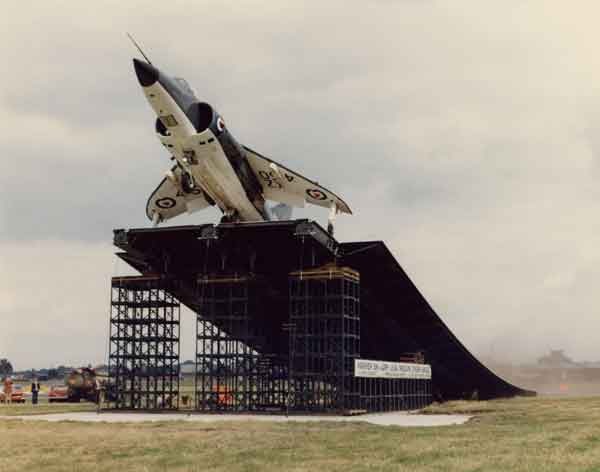
Development of the Harrier Ski-Jump
The development of the BAe Sea Harrier FRS.1 and the ski-jump are closely intertwined and the discussion one almost always leads to the di...
This was in '82 (though a much shallower angle):
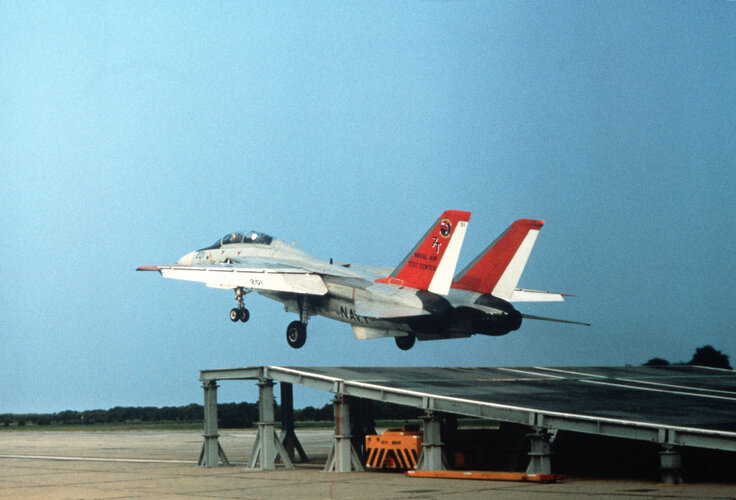
Firefinder
ACCESS: Top Secret
- Joined
- 5 October 2019
- Messages
- 1,050
- Reaction score
- 1,906
Needs to be pointed out that the first use of a Plane Ramp was in WW2 on the HMS Furious to help her launch Fulmars better during one of the attacks on Tirpitz.
With the US NACA doing a study on them in 1952 when it was felt that Catapults wasn't going to be enough. With them suggesting that Catapults Ramp hybrid be the best.
Then in 1973 M. Phil came up with the current design. And after the usual political screwery they built multiple ramps to find the right angle to launch harriers that was then bolted to the HMS Invincible.
With the US NACA doing a study on them in 1952 when it was felt that Catapults wasn't going to be enough. With them suggesting that Catapults Ramp hybrid be the best.
Then in 1973 M. Phil came up with the current design. And after the usual political screwery they built multiple ramps to find the right angle to launch harriers that was then bolted to the HMS Invincible.
Scott Kenny
ACCESS: USAP
- Joined
- 15 May 2023
- Messages
- 11,676
- Reaction score
- 14,395
Still puts both elevators solidly in the way of aircraft movements on deck and/or flight paths.Not when it's a 14000-ton light carrier with limited freeboard expecting to spend a lot of time in the northern Atlantic. That elevator layout was chosen (apparently) for two criteria. One was to maximize availability in poor weather (hence the internal lift midships) and the other was to somewhat reduce enclosed volume as a cost measure (hence the notched elevator aft). That aft elevator is also well sheltered but allows transom access for an engine test stand, I believe.
It seems to have worked acceptably for the Spanish, who built one as Principe de Asturias.
Note that the original SCS layout did not have a ramp, as that idea hadn't even been tested in 1973-4, when SCS was being designed.
- Joined
- 16 April 2008
- Messages
- 9,616
- Reaction score
- 14,525
Still puts both elevators solidly in the way of aircraft movements on deck and/or flight paths.
It really doesn't.
The aft elevator is clear of everything. Rolling STO starts ahead of it, and VTOL isn't impacted because the spots are forward and aircraft slide in from port for landings anyway.
The forward lift is actually offset to starboard; it's clear of the landing area and the ramp. Looking at pics of PdA, the takeoff lane marking for the Harriers literally runs right along the edge of the forward lift.
Keep in mind that this is not a ship for high-tempo operations. It does not launch alpha strikes, it launches a couple of helos at a time to rotate the ASW picket stations, and maybe a pair of Harriers to go chase a Bear.
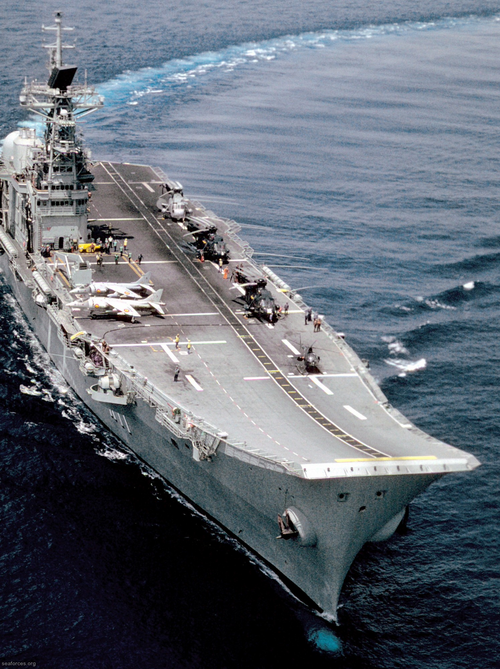
- Joined
- 26 May 2006
- Messages
- 34,922
- Reaction score
- 15,794
Hi,
in old magazine,I remember that I saw an artist drawing to a project
developed from XFV-12,but with inverted wing position,the canard
wing was high and the rear one was low.
That was mentioned in Arabic magazine Air Force by UAE,and of course they quoted it from a foreign sources,
but I am far away from my house now,has anyone obtain this stuff,certainly it was a future development of
XFV-12A.
BlackBat242
OK, I changed my personal text ;)
- Joined
- 10 April 2013
- Messages
- 1,482
- Reaction score
- 4,304
The test article was built on a tight budget... it had the forward fuselage, cockpit, and nose & main landing gear from an A-4 Skyhawk; and the intakes, wing box, and main fuel tank from a F-4 Phantom - totaling 35% of the structure.Sure. It is just surprising to me that they wouldn't build just one wing and blow a jet though it,
--BEFORE building the whole freaking airplane at max cost.
Risk reduction in project management, all the things we learn in school...
Similar threads
-
REQUIREMENT: US Navy VFA - V/STOL Fighters for Sea Control Ships
- Started by overscan (PaulMM)
- Replies: 5
-
MOVED: Rockwell NR-356 Sea Control Ship (SCS) V/STOL fighter (XFV-12A)
- Started by Stargazer
- Replies: 0
-
Rockwell NA-420, NA-430 and NA-431 (US Navy "Type A" proposals)
- Started by overscan (PaulMM)
- Replies: 13
-
-
NA/Rockwell 70's Stealth: Flying Banana, Silent Attack & Surprise Fighter
- Started by overscan (PaulMM)
- Replies: 51

